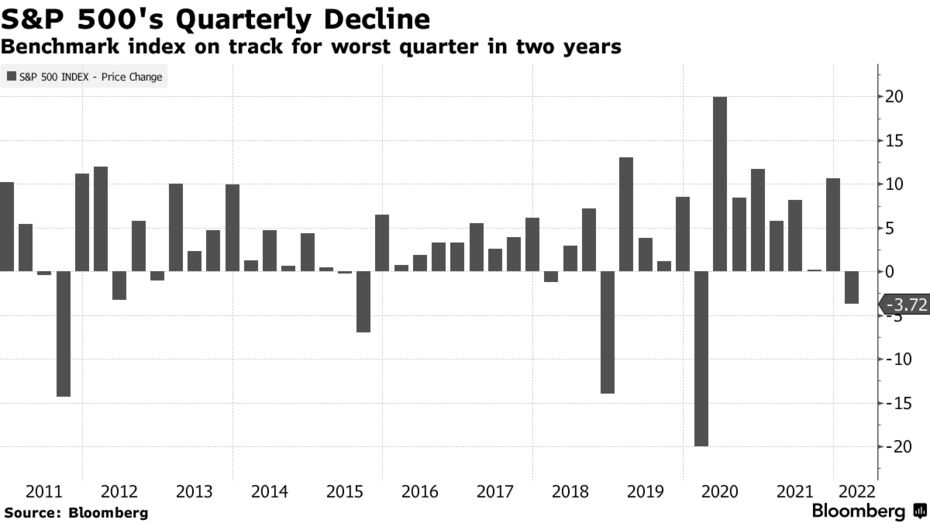- S&P 500 declines, Treasuries pare losses as oil prices fall
- Putin says gas exports will halt if ruble payments not made
U.S. stocks stumbled toward the first losing quarter since the pandemic bear market while Treasuries pared the worst losses in at least five decades. Oil slumped, but held above $100 a barrel in New York.
Moves in most financial markets were muted on the final day of a quarter that brought the twin threats of hawkish central banks bent on tamping down runaway inflation and the war in Ukraine. The S&P 500 edged lower, taking its loss in the three months to 3.6%, the most since March 2020. The two-year Treasury yield was steady after its 150 basis-point surge that is the most since 1984. Ten-year rates slipped, narrowing the spread to shorter tenors, as investors remain on edge over the threat a restrictive Federal Reserve will cause a recession.
Stocks, sovereign bonds and corporate credit all got hammered in the year’s first months amid concerns about a growth slowdown as central banks move to tackle inflation by withdrawing stimulus. Investors who piled into commodities fared best, riding massive gains in everything from oil to nickel and wheat. Yet the increases have exacerbated price concerns and may lead to a sharper response from central banks.
“The recent rally has masked a lot of pain over the past three months,” wrote Matt Maley, chief market strategist at Miller Tabak + Co.
A decline Thursday would mark the S&P 500’s 35th down day this year, the greatest number of first-quarter drawdowns since 1984, according to data compiled by Bloomberg.
Oil slid as the U.S. said it will release roughly a million barrels of oil a day from its reserves for six months, reversing an earlier price rebound ahead of an OPEC+ supply meeting. Meanwhile, stocks fell as U.S. inflation-adjusted spending declined last month as prices tempered demand.
Brent and West Texas Intermediate prices dropped about 4%, and European natural gas fell as Russia said it would halt gas contracts if buyers don’t pay in rubles.
“Aside from quarter-end considerations, oil is very much the center of attention,” Simon Ballard, chief economist at First Abu Dhabi Bank, wrote in a note to investors. Still, “all the usual suspects are still in play, keeping the market in check, including the specter of the Fed pursuing an aggressive path of monetary policy normalization over the coming months.”
Markets now see a strong chance the Federal Reserve will lift rates by a half point at its May meeting. The U.S. 2-year yield briefly exceeded the 10-year for the first time since 2019 on Tuesday, inverting yet another segment of the Treasury curve and reinforcing the view that Fed rate increases may cause a recession.
“This week’s brief inversion in the U.S. bond market, combined with elevated volatility on Treasury options, is a warning that the risk of U.S. recession should not be ignored,” wrote Lewis Grant, a senior portfolio manager at Federated Hermes. “U.S. bond markets are showing signs of stress. This is not mirrored in equities, where the VIX remains subdued and U.S. indexes trade above their pre-war levels. The bond market would appear to have a better handle on the potential risks.”
Some key events to watch this week:
- U.S. jobs report, Friday
Some of the main moves in markets:
Stocks
- The S&P 500 fell 0.1% as of 11:13 a.m. New York time
- The Nasdaq 100 fell 0.2%
- The Dow Jones Industrial Average fell 0.3%
- The Stoxx Europe 600 fell 0.7%
- The MSCI World index fell 0.4%
Currencies
- The Bloomberg Dollar Spot Index was little changed
- The euro fell 0.4% to $1.1116
- The British pound rose 0.2% to $1.3161
- The Japanese yen rose 0.3% to 121.42 per dollar
Bonds
- The yield on 10-year Treasuries declined two basis points to 2.33%
- Germany’s 10-year yield declined 10 basis points to 0.54%
- Britain’s 10-year yield declined four basis points to 1.62%
Commodities
- West Texas Intermediate crude fell 4.2% to $103.32 a barrel
- Gold futures rose 0.4% to $1,946.10 an ounce


![[Happy]](https://c1.itigergrowtha.com/community/assets/media/emoji_002_kaixin.d4dce72e.png)
![[Miser]](https://c1.itigergrowtha.com/community/assets/media/emoji_003_caimi.53908f82.png)
![[Sigh]](https://c1.itigergrowtha.com/community/assets/media/emoji_029_tanqi.d9153825.png)
